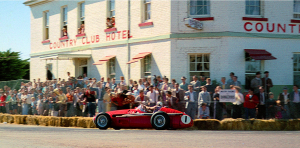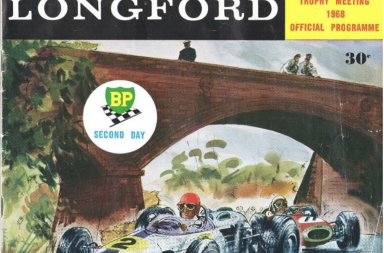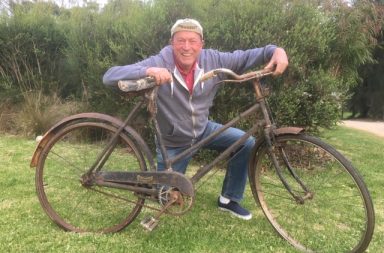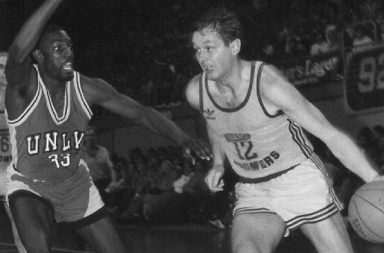NEIL KEARNEY
The old bloke driving me out of the bottom pub’s car park onto Wellington Street asked in a slow drawl if there was any traffic coming from my way.
“Yes! A big truck carting hay bales!” I shouted.
I’d forgotten that old Jack had a stiff neck and was deaf as a post in his left ear. When he failed to hit the brakes, all I could do was brace myself for the worst.
As the truck heaved and lurched to a grinding halt two metres shy of crushing our little car, Jack casually swung right, blissfully unaware of how close we’d come to becoming history.
Still, if I had to go, it would have been every Longford lad’s dream ending – in a prang on pub corner of the motor racing circuit, being driven by Jack Brabham.
It was 1993 and Jack was in Tassie to drive a new Honda sports car for Greg Crick. It was also the 25th anniversary of the last ‘long weekend at Longford’, and triple world formula one champion Brabham was as attached to Longford as the town was to him.
We had spent a pleasant hour at the Country Club hotel filming a feature about the Long Weekend at Longford for Channel 9’s Wide World of Sports.
The gregarious Greg Saunders was serving behind the bar and Mick Walker was happily sharing a few reminiscences with Australia’s motor racing legend.
For many locals, the pub was the focal point of the long weekend at Longford. It was where the town connected with the open road circuit. On a wall of the pub there’s a great photo of some drinkers hanging out of the pub’s top windows to watch the races, while those at ground level were ‘protected’ by netting wire. Yes, racing at Longford really was unique. The March long weekend of 2018 marks the 50th anniversary of the last motor racing long weekend at Longford. Thus, we are filled with nostalgia. The soundtrack we used for that channel 9 feature was Simon and Garfunkel’s Bookends theme:
“Time it was
And what a time it was, it was
A time of innocence
A time of confidences”
As Jack studied the photos on the walls, he recalled how the drivers crowded into the pub on the Saturday night to skite about their day’s racing. They’d buy ‘The Express’ from paperboys (among them young Peter Jones and Frits de Bruyn) and compare their results. These were the fastest motor aces in the world, but they belonged to a time of humility, when even the world’s best behaved like amateur sportsmen. There was no rock star posturing. Brabham recalled that everyone enjoyed the camaraderie of Longford so much they would never have thought of putting themselves above anyone else. (Brabham, by the way, was world formula one champion in 1959, 1960 and 1966).
On so many levels, the long weekend at Longford was unbelievable. How a sleepy town at the bottom end of the world came to host so many world champions, Jackie Stewart, Graham Hill, Phil Hill, John Surtees and of course Brabham, is a dream beyond anyone’s wildest fantasies.
Those of us who witnessed that era know we were touched by a magical event. What a time it was, a time when kids raced around the schoolyard for the month before the races, pretending they were Brabham or local hero Gene Cook.
In the week before every March long weekend we watched the local caravan park fill up with tents and vans. There were motorbikes, sidecars and race-cars on trailers alongside the tents. Campers by night became speed demons by day.
The racers flocked to our road circuit, with its two wooden bridges, convict-built pub and viaduct, tree-lined roads, hedgerows and the railway crossing between pub corner and Tannery Strait. Jack shook his head and laughed at the picture of Stan Jones (father of 1980 world formula one champion Alan Jones) airborne as he flew over the train tracks. That picture is behind the headline to this article.
Races were even interrupted when the Tasman Limited train passed through on its daily commute between Hobart and the northwest. In 1963 the train stopped a sports car handicap, which gave the mechanic of Symmons Plains pastoralist and racer John Youl enough time to remove the gearbox from Bib Stillwell’s Cooper Monaco and install it into Youl’s open wheeler for the main event. Another piece of Longford folklore is that, at the start of one Longford meeting, Youl’s bonnet was opened to reveal a mob of chooks.
In the bar of the bottom pub in 1993 Mick Walker recounted to Brabham the time that Mick’s brother ‘Rocky’ became overly emotional at his tavern halfway down Tannery Strait. Between races, ‘Rocky’ staggered out into the middle of the road and challenged the drivers to prove their skills by passing either side of him. The next race was held up, until marshals summoned club secretary and local electrician Ian Carins to appease ‘Rocky’ and convince him that he would be more comfortable sitting quietly on the veranda of his tavern.
Brabham’s transport truck once broke down on the morning of the South Pacific grand prix, so Jack thought nothing of driving his open wheeler the 20km through normal traffic from Launceston to Longford. Jack won the grand prix that afternoon and nominated a farmer on an old tractor as his day’s most stubborn opponent.
In 1963 Lex Davison crashed his Repco Brabham on pub corner. One wheel flew so high it narrowly missed a lady watching from the pub’s upstairs window. When the screeching subsided and dust settled, we nervously prized our eyes open to see Lex step out of the remains of his car. He nonchalantly strolled into the bar and tossed down a beer. That bar is now called the Lex Davison bar.
Lex was one of the gentleman racers. In the Longford years, enthusiasts either had a motor business (e.g. Bib Stillwell, Bob Jane and Bill Patterson) or were mechanics, or they crewed for others.
It was such an egalitarian spirit that local drivers and motorcyclists rubbed shoulders with the sport’s global elite. And cars such as Kerry Cox’s ‘purple petrol eater’ become celebrated, not the least for his swerving back-and-forth when trying to hang onto control across the Long Bridge. Folklore has it that the frogmen were already in the water by the time the ‘petrol eater’ reached the other end of the bridge.
We kids wanted to be everywhere on the 7km circuit. Many of us would walk at least one lap in a day, taking every vantage point. When we felt really game, we chose our moment between races to dash across the starting grid from the public area into the pits. Many of the kids, Greg Crick, Greg Preece and John Talbot included, later raced cars.
These days, whenever and wherever I mention that I come from Longford, the frequent response is “Ah yes, the motor racing”.
The long weekend was such a fabled part of our lives that reminiscences still take over conversations. It meant that much to everyone who saw it.
There have been a few attempts at revivals. Sadly, revivals can never be the real thing.
Back in 1993, when Jack took me for a spin around what’s left of the old circuit, even the frightening experience of coming out of the pub car park couldn’t quell my excitement. Jack remembered the names of every landmark on that track, and recalled just about every nuance of the surface. He wasn’t given to big statements, so I was taken by surprise when he said how much he had loved Longford. When we powered up Newry Hill, onto the Flying Mile, Jack gave Cricky’s Honda full throttle, just for a few nostalgic revs. In Longford’s heyday, his Brabham car lapped at an average 169 km per hour. Jack wanted to take a run under the Viaduct, which I explained was no longer accessible to motorists. Jack insisted. I opened a gate into Mountford and we drove as far as we could go towards where Kings Bridge once spanned the river. By that point, Jack really had the taste for Longford again!
That was 25 years ago. Jack Brabham passed away in 2014.
Now it’s fifty years since the last long weekend at Longford. And the lyrics of Simon and Garfunkel sum up the legacy with which we are left:
“Long ago it must be
I have a photograph
Preserve your memories
They’re all that’s left you”.
www.neilkearney.net.au

Credit: Pat Smith/oldracephotos.com



